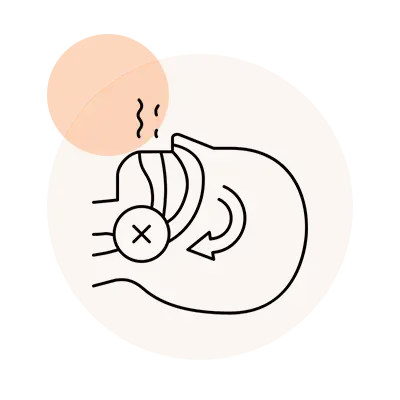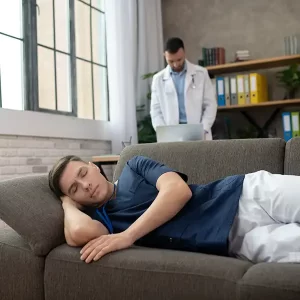Obstructive Sleep Apnea Treatment
What Is Obstructive Sleep Apnea?
Obstructive sleep apnea (OSA) is a condition in which breathing is disrupted during sleep. It occurs when the throat muscles relax and collapse, blocking the upper airway and preventing air from flowing into the lungs.
Also called obstructive sleep apnoea, people with OSA may stop breathing for anywhere from a few seconds to several minutes. This causes their blood oxygen to drop which then triggers them to wake up just enough to start breathing again.
These breathing pauses (called apneas) can occur dozens or hundreds of times each night and significantly reduce the quality of sleep. Most people don’t know this is happening, but wake up still feeling fatigued even after a full night’s sleep.
Obstructive sleep apnea is a chronic disease with serious health consequences if left untreated. If you think you may have OSA, it is important to see an ENT specialist for a diagnosis and to discuss the available treatment options.
What Are The Symptoms Of Obstructive Sleep Apnea?
Obstructive sleep apnea can have a varied range of symptoms, some which are typically associated with sleep disorders and others which may not be immediately clear. As a result, many people with OSA remain undiagnosed and untreated.
The most common symptom of obstructive sleep apnea is snoring. During an apnea episode, the person may snore loudly and make gasping or choking sounds, however not everyone who snores has OSA. Light or occasional snoring can be normal in adults. It is important to seek a professional diagnosis from an ENT doctor for snoring related to sleep disordered breathing.

Obstructive sleep apnea symptoms include:
- Loud snoring
- Gasping
- Pauses in breathing
- Restless sleep
- Teeth grinding
- Dry mouth or sore throat
- Excessive daytime sleepiness
- Morning headache
- Poor concentration
- Mood changes and irritability
Obstructive sleep apnea ranges from mild to severe. In severe cases, sleep can be interrupted hundreds of times each night with long pauses in your breathing. As a result, you may not get enough deep, restful sleep and will feel tired during the day.
Severe sleep apnea can lead to health conditions such as heart disease, stroke, hypertension, and diabetes. It may increase the risk of accidents and injuries due to fatigue. The symptoms of severe OSA can also impact your partner’s quality of sleep and have a detrimental effect on your relationship.
What causes obstructive sleep apnea?
Obstructive sleep apnea is caused by a blockage of the upper airway, which may be due to various lifestyle factors or physical abnormalities. In adults, OSA may be caused by being overweight or obese, however can also occur in people who are not overweight if there are other issues in their airway. Obstructive sleep apnea in children is typically related to large tonsils and adenoids.
Obstructive sleep apnea is the most common sleep disorder and can affect people of any age, gender and build. It is more prevalent in middle-aged and older adults and affects men more frequently than women. However, there is no one cause for OSA and the condition is multifactorial for almost all patients.

Risk factors for obstructive sleep apnea:
- Being overweight or obese
- Having a large neck circumference
- Having inflamed or enlarged tonsils and adenoids
- Nasal congestion due to an allergy or cold
- A structural problem with the shape of your nose, neck or jaw
- Taking certain medications such as sedatives or muscle relaxants
- Drinking alcohol
- Being a smoker
- Sleeping on your back
- Family history of OSA
- Certain medical conditions
Breathing difficulties during sleep may also be related to central sleep apnea (CSA), which occurs when the brain fails to send the proper signals to the muscles that control breathing. Unlike obstructive sleep apnea, which is caused by a physical obstruction of the airway, CSA is a neurological condition. For people with central sleep apnea, the apneas last longer and occur more frequently as the body does not make an attempt to breathe during these pauses. It is important to consult an ENT or sleep specialist for a professional diagnosis.
How is obstructive sleep apnoea diagnosed?
Obstructive sleep apnea is diagnosed using a combination of medical history, physical examination, and sleep studies. Medical history and physical examination can help to identify risk factors for OSA, such as being overweight or having a family history of the condition. Sleep studies are used to confirm the diagnosis and assess the severity.
A patient’s partner may be the first to notice loud snoring and witness episodes of a complete absence of breathing during sleep which can indicate OSA. Patients who are excessively sleepy during the daytime may be at increased risk of problems arising from sleep apnea. The doctor will ask about these symptoms and conduct a physical examination, looking for signs of OSA such as enlarged tonsils or a narrow airway. Special tests may occasionally be ordered, such as an MRI or CT scan.
A sleep study can be performed in a sleep laboratory or hospital, or at home using a portable monitor. Sleep studies measure things such as brain activity, heart rate, oxygen levels, and breathing patterns. This allows the doctor to get a clear picture of what is happening during sleep and can help to identify any patterns that may be indicative of OSA.
Sleep apnea is diagnosed as mild, moderate or severe depending on how many apnea events the patient has per hour. An event is when there is a complete or partial loss of breath for a minimum of 10 seconds.
- Normal sleep: < 5 events per hour
- Mild sleep apnea: 5 – 14 events per hour
- Moderate sleep apnea: 15 – 29 events per hour
- Severe sleep apnea: > 30 events per hour

What are the options for treating obstructive sleep apnoea?
 Obstructive sleep apnea is highly treatable with both surgical and non-surgical measures depending on the severity of the condition. In general, treating sleep apnea focuses on relieving the obstruction in the airway which helps the patient to sleep more easily and reduces the associated health risks. With a proper diagnosis and treatment plan, most people with OSA find that their symptoms improve.
Obstructive sleep apnea is highly treatable with both surgical and non-surgical measures depending on the severity of the condition. In general, treating sleep apnea focuses on relieving the obstruction in the airway which helps the patient to sleep more easily and reduces the associated health risks. With a proper diagnosis and treatment plan, most people with OSA find that their symptoms improve.
For mild obstructive sleep apnea syndrome, lifestyle changes such as losing weight, avoiding alcohol before bed, and sleeping on your side (positional therapy) may be enough to alleviate the condition. If these changes are not effective, the doctor may recommend the use of a breathing machine or dental appliance. For patients who cannot sleep with such devices and have moderate to severe obstructive sleep apnea, surgery may be helpful.
Continuous Positive Airway Pressure (CPAP):
CPAP therapy is the primary treatment for sleep apnea. It involves a small machine which pumps a steady stream of air through a mask, which is worn during sleep. This air pressure is just enough to keep the airway open and prevent pauses in breathing. CPAP machines are relatively quiet and easy to use. However, some patients find them uncomfortable to wear which limits their effectiveness.
Bilevel Positive Airway Pressure (BiPAP):
BiPAP therapy is another option to treat OSA through upper airway stimulation. The machine monitors the patient’s breathing cycle and delivers two different levels of air pressure – higher during inhalation and lower during exhalation. Bilevel PAP therapy may be more comfortable for some obstructive sleep apnea patients because it allows them to exhale against a lower pressure. This can be especially helpful for those with underlying respiratory problems, such as emphysema and chronic bronchitis.
Mandibular Advancement Devices (MAD):
Mandibular Advancement Devices are a type of dental appliance that are specially designed to fit over the patient’s teeth during sleep. They work by bringing the lower jaw forward which opens up the airway and reduces the risk of obstruction. Some patients may experience minor side effects from wearing a MAD, such as soreness of the teeth or gums, but these typically resolve with time. Oral appliances are an alternative treatment for some people with mild or moderate obstructive sleep apnea or patients with severe OSA who can’t use CPAP therapy.
Obstructive Sleep Apnea Surgery:
Surgical treatment for obstructive sleep apnea can be used to remove excess tissue from the airway or widen the nasal passage. Surgery is generally only recommended for patients who do not respond to other forms of treatment. It can sometimes cure OAS, but more often helps to reduce the severity of the disorder and support medical therapy, such as CPAP.
How is obstructive sleep apnea surgery performed?
Modified Uvulopalatopharyngoplasty (UPPP), Expansion Pharyngoplasty, Transpalatal Advancement Pharyngoplasty
The surgeon modifies the obstructing tissues of the back of the throat, including the uvula and soft palate, in order to widen and stabilise the airway.
Maxillomandibular Advancement (MMA)
The upper and lower jaw bones are surgically moved forward to create more space in the airway. MMA is generally combined with other procedures, such as soft tissue surgery, to achieve the best results.
Septoplasty, Turbinoplasty, Rhinoplasty
The surgeon straightens the cartilages and bone to correct a crooked partition between the nostrils (deviated septum). Nasal surgery is designed to improve breathing and help with the use of a CPAP machine for treating obstructive sleep apnea.
Tongue Reduction Surgery
When tongue size and position are identified as contributing factors to OSA, the surgeon can remove excess tongue tissue to increase the airway capacity in the area behind the tongue. This can be achieved effectively via radiofrequency, coblation, midline glossectomy, lingual tonsillectomy and other variants.
Genioglossus Advancement
The tongue muscle that is attached to the lower jaw is pulled forward, making the tongue firmer and less collapsible during sleep.
Adenoidectomy & Tonsillectomy
Surgery to remove the adenoids and/or tonsils will resolve the issues related to obstructive sleep apnea in most children. UPPP may also involve removal of the tonsils and adenoids.
Hypoglossal Nerve Stimulation (HGNS)
Surgical implantation of a small electrical stimulator which results in opening of the airway muscles in sleep. HGNS devices are not yet available in Australia but expected in 2024 pending regulatory approval.
What to expect after obstructive sleep apnea surgery?
Although it can mitigate the severity of the disorder, the primary aim of surgery for obstructive sleep apnea is to improve the patient’s symptoms or potentially return them to device use, including CPAP and oral appliance therapy.
Surgery is generally performed as an overnight procedure, and most people are able to go home the next day. However, it is important to follow the surgeon’s postoperative instructions carefully to ensure a successful outcome.
Recovery times vary depending on the type of surgery performed. For example, uvulopalatopharyngoplasty (UPPP), which involves removing excess tissue from the back of the throat, usually requires a week or two of recovery time. By contrast, maxillomandibular advancement (MMA), which involves moving the upper and lower jaw forward, may require several weeks of recovery.
Pain is the most frequent symptom following OSA surgery because it can be caused by swallowing, talking and coughing. It often peaks between 4 to 7 days after the procedure, but may last for 2 weeks, resulting in limited oral intake and weight loss. In rare cases, patients may experience more serious complications such as an infection or bleeding.
Follow-up appointments will be timed based on the surgery and the presence of any complications. With proper care, OSA patients can expect a full recovery and an improved quality of life after surgical treatments.

Discuss your options for Obstructive Sleep Apnoea Treatment with a specialist from Complete ENT
Want to Schedule an Appointment?

Call us on
07 3905 5999


